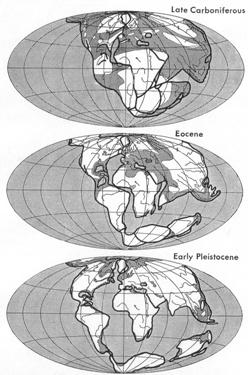Geologist and science writer Nina Morgan celebrates a Christmas gift that sparked off a geological revolution
 Picture: The first map of Pangaea, envisioned in the mind of Alfred Wegener: the gift that keeps on giving.
Picture: The first map of Pangaea, envisioned in the mind of Alfred Wegener: the gift that keeps on giving.
In 1910, the roommate of Alfred Wegener (1880-1930) was given a copy of the newly revised 5th edition of Andree’s Handatlas for Christmas. “For hours we admired the magnificent maps” Wegener wrote to his then fiancée (later wife) Else Köppen. And then, he reported, inspiration struck. “A thought occurred to me …Does not the east coast of South America fit the west coast of Africa as though they had been contiguous in the past? Even better is the fit seen on the bathymetric map of the Atlantic when comparing ... the break-off into the deep sea. I must follow this up.” The result of his further investigations led to his proposing the theory of continental drift - the idea that the break-up and drifting apart of a supercontinent, Pangaea, from the Late Palaeozic , was responsible for the configuration of continents and oceans that we see today.
As long ago as 1620 Francis Bacon had noted the way that modern day continents fit together. But when Wegener, then better known as a physicist and meteorologist, presented the theory of continental drift at a meeting of the Geologische Vereinigung(GV) in 1912, and that same year published it in Peterman’s Geographische Mitteilungen and in the GV journal, Geologische Rundschau, the initial response within the geological community was outrage. No one could envisage a mechanism by which continents could be moved.
But nevertheless the seeds were sown, and the rest, as they say, is history. Supporters of the continental drift theory emerged, mechanisms were proposed. Today there are few, if any, geologists who don’t subscribe to the theory of plate tectonics.
But as well as moving mountains, the theory of continental drift also stimulated academic minds and promoted the idea of collaborative science. Wegener acknowledged that even those colleagues who remained sceptical about continental drift were generous in contributing the references he needed to back his theory, saving him, he noted, “nine tenths of my time”. And it can be argued that the search for a mechanism to explain continental drift led to the widespread application of geophysics in marine geology. This, in turn resulted in the discovery of mid-ocean ridges and deep-sea trenches, and demonstrated that far from being flat and boring – the sea floor is, tectonically speaking, where it’s at.
In terms of generating new theories, opening up new fields of research and stimulating new ideas that lead to a greater understanding of many areas geology, that copy of Andree’s Handatlas has certainly proved to be the Christmas gift that changed the world.
A happy holiday season to all!
Acknowledgments
Sources for this vignette include: Alfred Wegener, 100 years of mobilism by Wolfgang R. Jacoby, Geoscientist, vol 22 no 9, October 2012; How plate tectonics clicked, by Naomi Oreskes, Nature, vol 501, 5 September 2013, pp. 27-29; Dating the Spreading Seafloor, chapter 12 in Much Ado about [practically] nothing: a history of the noble gases, by David E. Fischer, OUP, 2010 [ISBN 978-0195393965]. For more background on continental breakups and plate tectonics see:
Supercontinent by Ted Nield, Granta, 2007 [ISBN 978-0674032453]
If the past is the key to your present interests, why not join the History of Geology Group (HOGG). For more information and to read the latest HOGG Newsletter visit the HOGG website at:
www.historyofgeologygroup.co.uk, where you’ll find abstracts for the talks and posters presented at the Conference on Geological Collectors and Collecting, April 2011 available free to download as a pdf file.
*Nina Morgan is a geologist and science writer based near Oxford.